The hum of anticipation, like the gathering clouds, hung over the fifth stage of Mount Fuji, the preferred starting point for climbers to begin their ascent of Japan’s highest and best-known mountain.
They fueled up on noodles and curry, complete with a conical-shaped portion of rice, while those coming in the opposite direction bought mementoes of their time on the sacred peak — everything from branded whisky to Fuji-shaped cakes.
The only physical reminder that Fuji-san, an active volcano that last erupted in 1707, is also a place of worship was a Shinto shrine, its crimson torii gate almost touching the walls of a souvenir shop and restaurant.
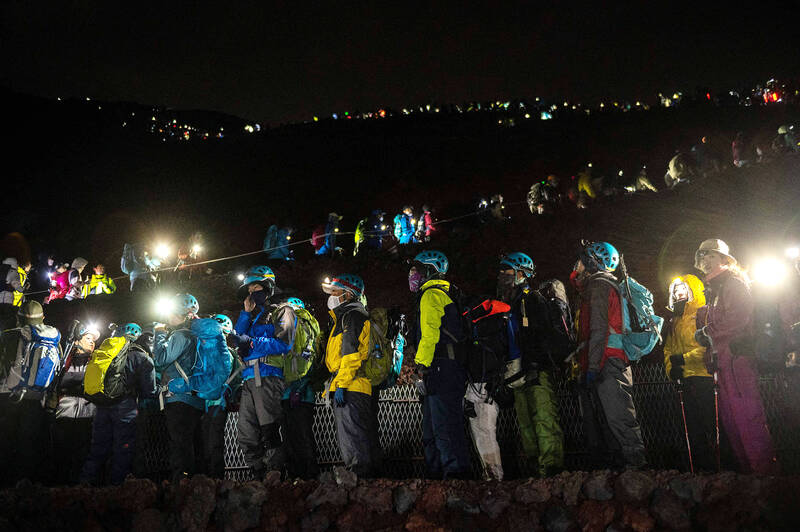
Photo: AFP
In 2013, when Unesco made the mountain a world heritage site, it described it as a historic place of pilgrimage that had inspired countless artists and poets.
While it still inspires awe, especially when viewed from a distance, Fuji is attracting huge numbers of visitors, who risk adding the mountain to a growing list of victims of tourism pollution, from
Amsterdam to Machu Picchu.
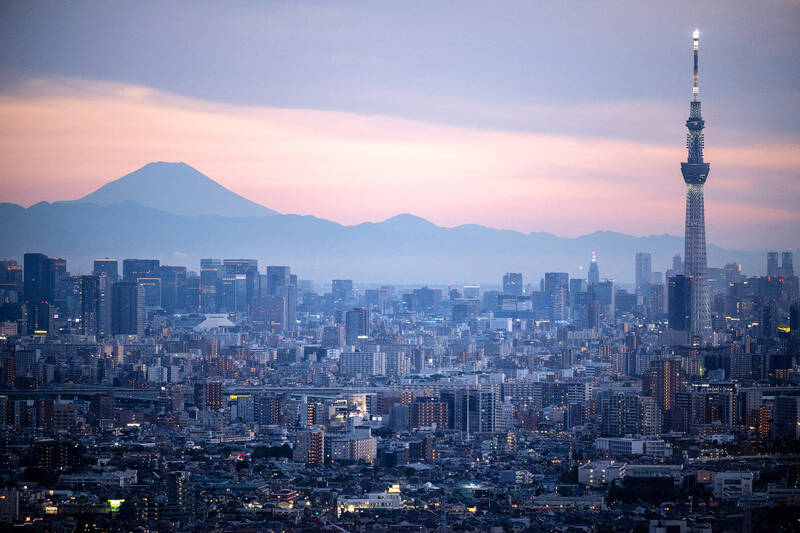
Photo: AFP
More than 2.3 million people visited the 2,400-meter-high fifth stage — with a smaller number continuing to the 10th and highest stage — in 2012, according to the local government in Yamanashi, one of two prefectures straddled by the mountain. By 2019, that number had more than doubled, to just over 5 million. In July, when the annual climbing season opens, about 65,000 hikers reached the summit, an increase of 17 percent from 2019.
Measures targeting polluting cars have reduced the number of private vehicles, but these have been replaced by an explosion in the number of buses, each depositing yet another large group of hikers. Overcrowding is placing unprecedented pressure on limited toilet facilities, creating mini mountains of litter and, say local guides, increasing the potential for accidents. Seasoned climbers find their route up the higher stages of the mountain blocked by large groups of inexperienced visitors, including those who, deceived by the gentle curve of its slopes on picture postcards, have underestimated the scale of the physical challenge that lies ahead.
“Over-tourism is the biggest problem,” said Masatake Izumi, a Yamanashi prefectural government official and expert on the history and culture of Mount Fuji.
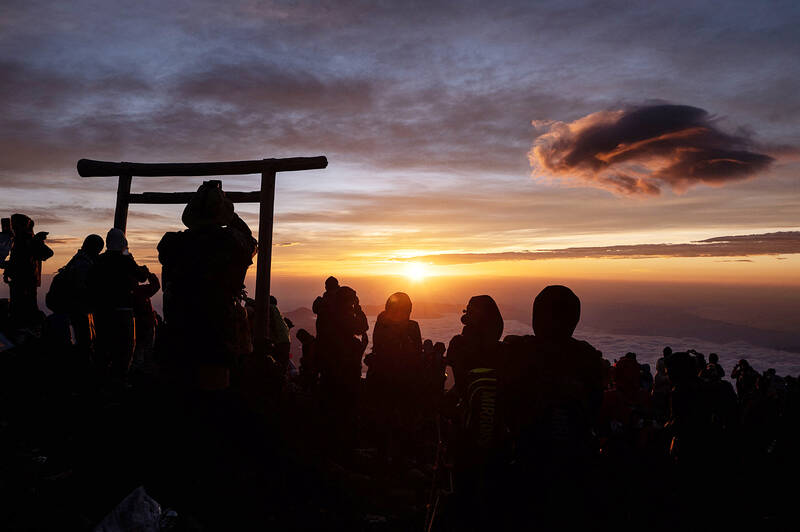
Photo: AFP
Izumi was skeptical of the potential economic benefits from encouraging more visitors.
“People on tour buses climb the mountain, buy an ice-cream on the way down and get straight back on the bus,” he said. “That’s it.”
On a recent morning, the trail leading to the sixth stage was busy with holidaying couples and occasional lone climbers. As the clouds descended and the temperature dropped, the trickle turned into a flood, as they were joined by parties of tourists from China and Taiwan, chatting as they planted their mountain sticks in the loose volcanic sand. Above, it was just possible to make out the heads of hikers as they zigzagged up another stage, taking them closer to the 3,667m summit.
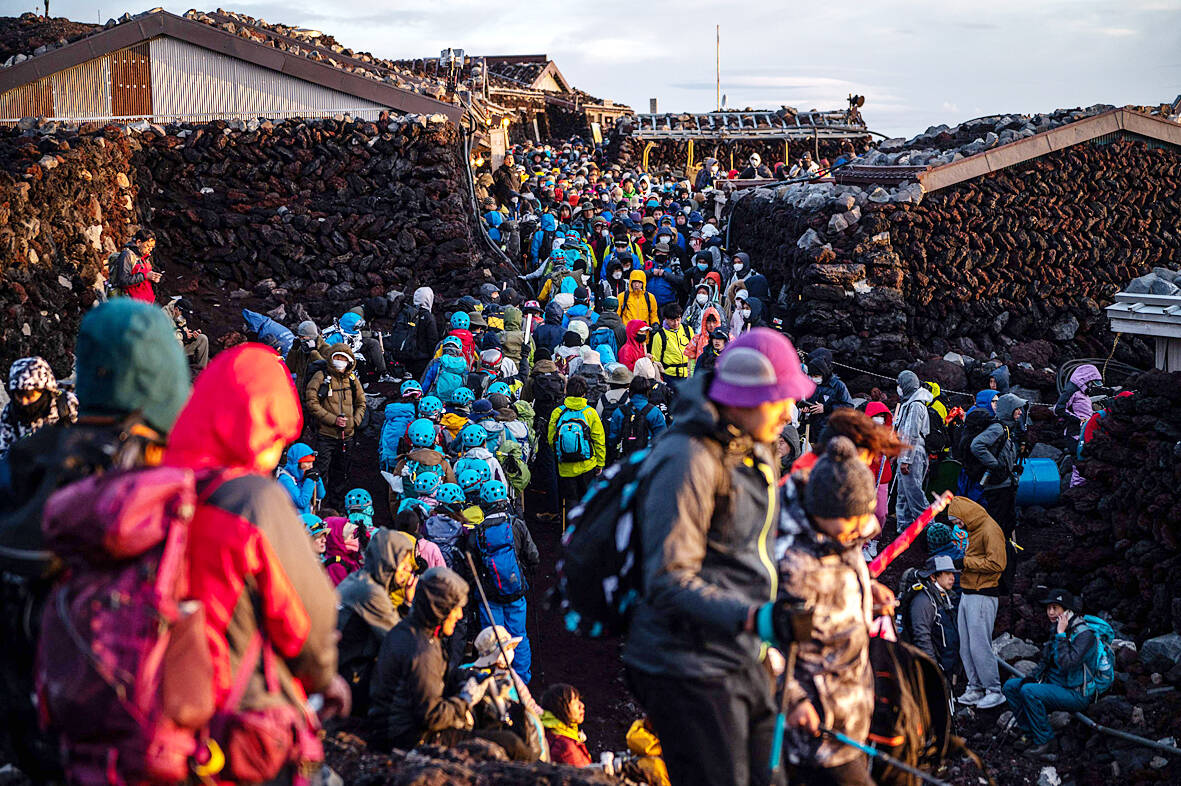
Photo: AFP
“It looks crowded today, but we get at least 10 times this number at weekends,” Izumi said.
Martijn van der Akker and Leanne Schuurman, a couple from the Netherlands, said climbing Mount Fuji had long been on their bucket list.
“We don’t get mountains like this at home,” said Schuurman.
They planned to continue to the seventh stage and rest overnight before reaching the summit to witness the sunrise.
“You come to places like this to experience nature, and if there are too many people, where is the beauty in that?” van der Akker said.
They said they would happily have bought tickets in advance if it meant being able to experience the mountain in relative solitude.
“If preserving the environment means having fewer people, then who are we to say no to an admission fee?” he added.
While officials have ruled out a blanket ban on hikers of the kind that has been in place on Uluru in Australia since 2019, the Yamanashi governor, Kotaro Nagasaki, has proposed the construction of a light railway — built on the current toll road — to control the number of people accessing the fifth stage.
“We need a shift from quantity to quality when it comes to tourism on Mount Fuji,” Nagasaki said this week.
Back at the fifth stage, a caretaker complained as she struggled with huge yellow bags of litter retrieved from the public toilets. “It’s incredible … I’ve filled 14 bags just today,” she said. “Something has to be done.”
Over-tourism has led to an increase in people needing first aid in an area miles from the nearest hospital.
“There are a lot more visitors, and that means we are getting busier,” said Shinsaku Hama, a registered nurse who triages injured or sick climbers at a medical center on the fifth stage.
Aside from twisted ankles, cuts and bruises, the center treats people who have not reckoned with the thinner air, who arrive suffering from chest pains, breathing problems and occasionally life-threatening conditions.
“We’ve had about five cases in which people needed to be taken to hospital already this season,” Hama said.
A growing problem is “bullet climbing” — a reference to underdressed, poorly equipped hikers who head straight to the summit without resting overnight in mountain huts — an approach that raises the risk of altitude sickness and hypothermia.
“Mount Fuji is not just any mountain,” Masayuki Oishi, from the Mt Fuji World Heritage Division, told the Mainichi Shimbun. “We want people to enjoy the climb, but they need to be properly prepared.”
Eniko Csapo, a Hungarian tourist, has dreamed of climbing Mount Fuji for years.
“I’m never surprised to find that places are crowded in Japan,” said Csapo, who has visited the country several times.
“This isn’t the place to come to make a solitary climb … everyone has the same dream,” added Csapo, who had brought a plastic bag for her rubbish. “You say Fuji and everyone knows what you mean. I know it’s going to be crowded on the way up. But it’s important to be respectful … some people don’t realize that this is a holy mountain.”

June 9 to June 15 A photo of two men riding trendy high-wheel Penny-Farthing bicycles past a Qing Dynasty gate aptly captures the essence of Taipei in 1897 — a newly colonized city on the cusp of great change. The Japanese began making significant modifications to the cityscape in 1899, tearing down Qing-era structures, widening boulevards and installing Western-style infrastructure and buildings. The photographer, Minosuke Imamura, only spent a year in Taiwan as a cartographer for the governor-general’s office, but he left behind a treasure trove of 130 images showing life at the onset of Japanese rule, spanning July 1897 to
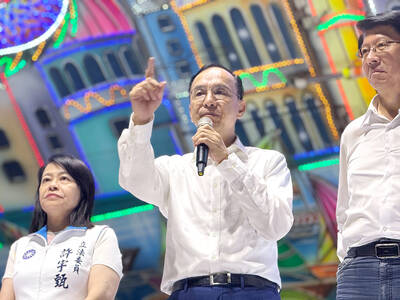
In an interview posted online by United Daily News (UDN) on May 26, current Chinese Nationalist Party (KMT) Chairman Eric Chu (朱立倫) was asked about Taichung Mayor Lu Shiow-yen (盧秀燕) replacing him as party chair. Though not yet officially running, by the customs of Taiwan politics, Lu has been signalling she is both running for party chair and to be the party’s 2028 presidential candidate. She told an international media outlet that she was considering a run. She also gave a speech in Keelung on national priorities and foreign affairs. For details, see the May 23 edition of this column,

One of the most important gripes that Taiwanese have about the Democratic Progressive Party (DPP) is that it has failed to deliver concretely on higher wages, housing prices and other bread-and-butter issues. The parallel complaint is that the DPP cares only about glamor issues, such as removing markers of Chinese Nationalist Party (KMT) colonialism by renaming them, or what the KMT codes as “de-Sinification.” Once again, as a critical election looms, the DPP is presenting evidence for that charge. The KMT was quick to jump on the recent proposal of the Ministry of the Interior (MOI) to rename roads that symbolize
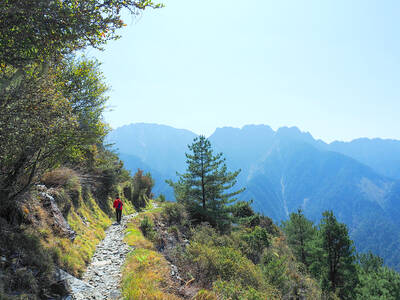
Jade Mountain (玉山) — Taiwan’s highest peak — is the ultimate goal for those attempting a through-hike of the Mountains to Sea National Greenway (山海圳國家綠道), and that’s precisely where we’re headed in this final installment of a quartet of articles covering the Greenway. Picking up the trail at the Tsou tribal villages of Dabang and Tefuye, it’s worth stocking up on provisions before setting off, since — aside from the scant offerings available on the mountain’s Dongpu Lodge (東埔山莊) and Paiyun Lodge’s (排雲山莊) meal service — there’s nowhere to get food from here on out. TEFUYE HISTORIC TRAIL The journey recommences with